Site 5 Libby Brown/Tony Perry
Remains to be Seen: R.E.M. and Eyeglasses of Kentucky
This is an edited transcript of the site talk/discussion/activity coordinated by Libby Brown, with Tony Perry as accomplice, that took place at Collins Place Eyecare, Melbourne, on Saturday June 5, 2004. This was the fifth site in the current AMPEdS program. In line with the spirit of the occasion an informal, conversational manner has been retained in the text.
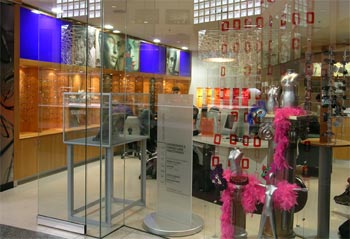
LIBBY BROWN: Oh, we're starting.
(begins with REM song Man on the Moon playing)
TONY PERRY: There's a soundtrack to this?
LB: I need to say something first. Great timing! There's my career as a stand-up comedian right out the window.
TP: Matthew Collings is going to storm through here in a minute in great big lumpy boots!
LB: The title of the talk is Remains to be Seen: R.E.M. and Eyeglasses of Kentucky.
(play music)
TP: Have we got an Appalachian mountain tape?
(music ends)
LB: What happened to the three-minute song?
In 1986 a group of students were in a lecture room, in a photography lecture room, and the lecturer was describing an image, and which they were not allowed to see for a fortnight. So, what had to happen in the interim was that people had to imagine what was being talked about, for a fortnight, as I said, before they got to see it.
And we are about to, via my accomplice Tony Perry, revisit that time and the description of the image.
TP: Yeah, what has happened to the three-minute song? If you want to hear the best song about teenage angst, two minutes twenty-five seconds, it's Carl Perkins doing Blue Suede Shoes - says it all! I've had to watch, spent all the morning watching, sound down, the videos, the music videos on the ABC: bizarre, bizarre - sex and death.
Ok. There's almost no point in doing this really, because most of the people here are going to go, "yeah, I know that photo!", having been around...
LB: They won't remember it!
TP: I can't remember exactly what prompted me to do this, it was either pure frustration, or I'd lost the slide. It could have been any number of things. I don't know what prompted it.
It was... from that point on I used the describing-only technique quite a bit as a means of getting peoples' imaginations working. The other thing I really wanted to get across, was that there's this point of view with photography, particularly that if given the same bits of material, any person with a camera and a bit of knowledge could make the same photo. Right? I would argue, with the best will and a copy of a photo in front of you, you'd still have trouble. But for a lot of people who, in their first year in photography school, used to wonder about how much imagination was involved, and whether or not they were going to succeed (did they have the imagination?), this was an exercise that proved to be quite useful. Inevitably people would have imagined a picture that had no bearing on the thing I was describing, didn't look anything like it. It was totally different, and especially given this particular picture, because it's not... well, I mean there's no such thing as a standard photo nowadays, now anything goes. But at the time hard-edged photography was preferable, if you like, to any other kind.
This photograph was one where the image was blurred. It was an interior shot, looking into a toilet. An old room, weatherboard, clapboard, as they would call it in Kentucky, which is where the image was made. There's a figure emerging and there's a shaft of light coming through a window at the side. There's a figure emerging, well, you're not really sure what it is because of the movement, because it's such a long exposure. All you can see with any - you can make decisions about it, you can say "ah! I can see genitalia", so it must be a man. Further up though it seems to transmogrify into a woman, it appears to have breasts. Also there's a shadow at the back of the image which tends to make the figure appear to have the long hair of a woman; and it resembled a 50's hairstyle so at the time it was made, it could have worked more dramatically than for people in the 80's or 90's, or so on. One leg is lifted and the shaft of light hits the leg and the leg appears as if it were turned into marble. So there is this sense of movement, but at the same time there's a sense of the thing being frozen, and changed, right from the organic to the inorganic. At the same time, it's a spectacularly simple picture. Its one of the simplest pictures you can imagine. But it's gorgeous, it's gorgeous!
(to LB) Do you want me to talk about Christian's work, I mean the reason why I'm here?
LB: You could do that later?
TP: Ok.
LB: The photograph was taken by Ralph Eugene Meatyard. He was an optician in Lexington, Kentucky and his shop was called Eyeglasses of Kentucky. He had a friend, Guy Davenport, who wrote a book called The Geography of the Imagination in which he writes about Gene Meatyard. In the context of today's site talk, and how I'd like you to engage with the erased book, I'd like to read the beginning of the first essay of the The Geography of the Imagination:
The difference between the Parthenon and the World Trade Center, between a French wine glass and German beer mug, between Bach and John Philip Sousa, between Sophocles and Shakespeare, between a bicycle and a horse, though explicable by historical moment, necessity, and destiny is before all a difference of imagination.
Man was first a hunter and an artist: his earliest vestiges tell us that alone. But he must always have dreamed, and recognized and guessed and supposed, all skills of the imagination.
What we have in the box at the back there, and in something I'll give you in a moment, are remains, evidence if you like, and I want all of you, even those people who've not handled this object before, you might want to go and have a look at it; just think about it.
We've provided this object and a space, both physical space and a space hopefully of the imagination, and you'll be actively encouraged to participate in certain strategies for seeing the work. Perhaps it might be useful if you see yourself, as Michael Ondaatje said in Coming Through Slaughter, as a 'fictional detective', and to respect in your own mind - as you do something for me on paper - to respect: "stray facts, manic theories and well-told lies", to "stumble on clues". And, you've come here, generally speaking, both, as Ondaatje says of this character, "amateur and accidental", and perhaps like me, "never professional in the brain".
So the approaches that you might use - and I'm going to be handing out pieces of paper, pencils, pens, whatever - the approaches that you might think about using are: a productive misreading of the work, deliberately misreading the work, detours, "cruising the piece", as Roland Barthes might say, a 180 degree turn, to dream something, to imagine something about this object or the process of its making, to have misunderstandings, to work against normative assumptions, and they may be guesses, hunches... I want you to try to be speculative and not simply to describe the object. Perhaps include: slips, gaps, deviations, or 'this reminds me of that', or 'what if?' Even a story is a possibility, because a story is way of thinking.
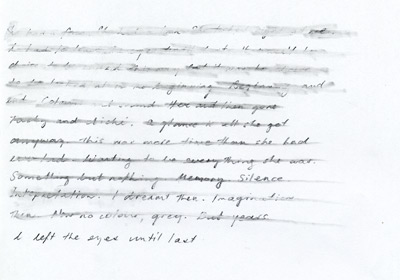
It may be helpful to think about trying to give this piece an individual reading that might not involve writing words. However, it might but you don't need to write sentences. I just want you to do it! The reading might be a drawing or whatever; your reaction to the piece, but preferably a reading with "blood pressure", as Dylan Thomas once described his own writing.
It may very well be for some people who are not used to doing this sort of thing, that it may be overwhelming, but why not be overwhelmed! Be, if you need to be, perverse, to rub the work against the grain. On the question of rubbing and rubbers, and just to help you get those imaginative juices flowing, I want to read you a poem, coincidentally also written in 1986. Tony originally spoke about the image in 1986, this piece was written in 1986, and the erased magazine was printed in 1986 - must have been a good year but I can't quite remember it!
TP: Hawke (Bob Hawke, Australian Labor Party Prime Minister [1983-1992] and one-time Guinness Book of Records fastest beer drinking record holder) was in power.
LB: What?
TP: Hawke was in power.
LB: Oh, ok. This poem was written in 1986 in a prison writing class for inmates; a five-minute exercise, unedited. To me it is a fine example of five minutes extremely well spent. It's called The Rubber.
Rectangular, elongated, on end.
Two-tone Duo-Plastic Staedtler
526 28 Germany
Rubber
Plastine eraser
resting on its blue
white two thirds upper most
Rounded
Hard-worked pencil portion
abrasive blue less battered
corners turned end flat
Resilient rub-a-dubb-dubb
from the Reich
Monolithic monument
Erect
ersatz rubber
on Formica
ersatz wood
Tiny technology
Teutonic technocratic
Tickler
White-man magic
Without a convoy
Disguised tyre technology
for WW III
who needs colonies anyway?
Tiny technology
Teutonic technocratic
Tickler
Trembling
Waiting for the humming
Skinny schizoid
Cynic schoolmam
Spinster
Sighing
Waiting for the coming
Horney Henretti
Hiccup housewife
Hipster
Hoping
Waiting for the caning.
LB: (handing out bags of rubber erasings) These may, or may not, help your creative juices, however...
TP: (referring to the bags of rubber erasings being handed out to a couple of people who had been involved in the erasing of the magazine) Some of you are getting it back!
LB: If you would like to find some sort of space, grab a pen, a pencil... This can be something that might have just occurred to you, annoyed you, irritated you, bugged you about doing the rubbing-out, at least for those people who were press-ganged into doing this. Maybe those people who have had nothing to do with this project so far, might be able to imagine other things about it.
Take about 15 minutes, or so... you're allowed to do it in partnership. Do you want to do this Tony?
TP: I'll do it... No, it won't take me five minutes. I've already thought about what I do... Where did the bag of pencils go?
LB: Hang on, who's got the bag of pencils? (A stranger enters the shop to buy some glasses) That's cool, just let him go for it! He can be part of the show.
TP: Where have all the good colours gone?
LB: I'm more than happy for it to be absolutely, almost nothing, whatsoever to do with the object. And I didn't give you the 'rubbits' for any real reason, but you made me think about 'rubbits', Bill (McCann).
(audience participation)
TP: I need some glue!
TP: (to the audience, with strong German accent) Your verk vill be marked at zee end of zee session!
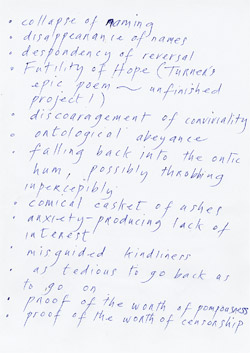
LB: I know this is probably not the time to do it, and I should have done it before, but it might prompt some thoughts for people. When this work went out to the press it was described as:
A mass-collaborative magazine erasure work informed by the exchanges we make in our lives, of material and non-material things, the looks we give and take, the objects that pass between us, the trading of our time and our labour, the values that accrue and the losses we incur in the process.
What this work asks us to consider, in its own mute way, are the condensed remains of a multitude of such exchanges having brushed up heavily against a culture obsessed with the idea of visibility.
(audience participation continues)
LB: (collecting the contributions) Has anybody... names, names, I want releases signed... releases definitely signed... how are we going... what's the time? I'm not going to read it, well not yet anyway... no, I'm not going to read them out, no... but I am going... no, I'm not going to read them out, but, I am going to ask - did you find the glue stick?
TP: (laughing) They will be published though!
LB: They will be published, and I'm taking credit for it by the way... well it was my idea! (laughs all-round) Isn't that how it works in the art world - I didn't make it but it was my idea!.
TP: (showing his contribution) You can see mine!
(lots of laughter)
LB: We can count on you!
ANONYMOUS: So obvious!
TP: Nothing wrong with being obvious!
LB: No, there's nothing wrong with being obvious.
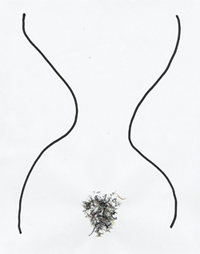
TP: Nothing wrong at all!
LB: I possibly don't need to say anything about why I did this today. I actually find it... and this is my own... maybe I'm just lazy. I'm not quite sure, yeah I am sure. I like to get people, to give people, the opportunity to think about things and to have their own voice. I suppose this is what I'm saying. And... I'm completely lost now... that's enough really isn't it; I don't need to say anymore than that.
But it is interesting, in that I mentioned to a couple of people that there was going to be some degree of participation; that I wasn't going to get up and just talk. And I could see people tense up. I was trying to describe what I thought about that to Christian, and it's, not sad, but it shouldn't come to that. Any opportunity one has to say what they feel about something, or think about something, or, to exercise the imagination, I think should, in theory, be grabbed with both hands because one doesn't get the opportunity all that often.
Those people who haven't done photography, and there are very few of you in the room that haven't, should have a look at Ralph Eugene Meatyard. Anybody who was born in Normal, Illinois, is ok in my book!
I want to thank everybody for coming and participating. I really want to thank David for - this is going to be very corny - having the foresight and the insight to host this today, and the book, and the magazine in its wee box, and also for being relentless in his pursuit of the perfect toric lens.
Now Tony is going to say something about the work and I also very much want to thank him for being my accomplice.
TP: You mightn't after this (laughs).
LB: Wait a minute. Two things I'm sure Tony won't mind me mentioning because this is something I wish someone had said about me. We used to have a mutual accountant who never had very much work to do on our tax forms, did he Tony? But his definition of Tony was: "the only person he knew who had neither feet on the ground". I was so peeved that he didn't say that about me!
I'm going to hand out something in a minute; it's a copy of the picture Tony was describing and also a bunch of quotes. And, I've got to say, my favourite one here was a piece of anonymous graffiti I saw on the way into London which said, "ONLY THE RIDICULOUS WILL SURVIVE!" Finally, most of all, I want to thank Tony Perry for giving me my second job in teaching photography, and for allowing me to be as ridiculous as I wanted to be; it is the best teaching method. Thank you.
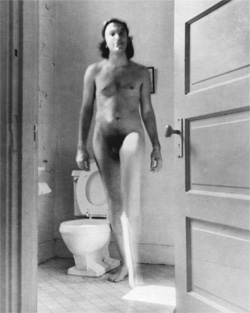
LB: Now, would you like to say something briefly about Christian's work?
TP: Yeah. I was just going to say... why I'm here. I've retired and as far as the art world is concerned, I don't care any more. So people who have got half decent work, normally I'd never come and talk to it, but I was really interested in this project when I went up to the Trades Hall Council (AMPEdS Site #4) with Libby and had a look at it. Not intrigued by what I saw, because there is nothing much to see, there's nothing much to see...
LB: Remains.
TP: And I remember, we chatted and chatted and chatted, and the one thing that kept nagging me all the time, all the way home thinking about this thing, was, that it was Vogue; it was a French Vogue... and the more I thought about it the more I started to think about the idea of the magazine as an assassin. These magazines are completely predicated on the idea of building up celebrity and then destroying it. Now, Vogue, French Vogue, doesn't go after its clientele like, say, Hello magazine, with a hatchet, and do unto whoever... one of the 'Spice Girls', Victoria Beckham. They do it another way, and it's even more insidious, and it's one of the weirdest things that infects the world in which we live; the whole notion of being fashionable.
What Vogue does is it takes someone, or some idea, or some notion, and makes it acutely fashionable, acutely, in the sense that there are some people whose whole lives depend on being seen, and being seen to be fashionable, and being seen to be a celebrity. Take the antics of Madonna as an example, her whole life is determined by this need to succeed in some fashion or other, in a celebrity sense.
At the same time, the very magazine that holds them up there is producing the next kind of fashion which will see them undone. The process just goes on. And it's an accelerated process now; it used to take a lot longer, but now it's an accelerated process. It's rather like watching time speeded-up in a motion picture, things rushing past. I suppose when I made that link I was trying to restore something that had gone missing from the magazine (laugh). That was the idea; it was to, somehow, put back, in the most obvious form possible, the thing that was most obvious about the magazine, what it was selling; the idea of glamour and sexuality as centred in the woman, and the woman's world. That's the most interesting thing about Vogue magazine, it is, was, the least troubled by notions of feminism, it just kept going. And at the time, I remember, I don't know what date... what date would that be Christian? What date would that (magazine) be?
LB/CHRISTIAN CAPURRO: 1986.
TP: 86? Ok. In the seventies and early eighties, the hottest product, the hottest photographer around, in a commercial sense, a fashion sense, was Guy Bourdin: French photographer, loony, strange, a strange disturbed man. His photographs were always, could always guarantee to sell that particular issue... Giving him the editorship from time to time for the whole magazine would guarantee that it would sell, because there was a sadomasochistic quality to his pictures. A sense of women in danger, women under threat, not like Helmut Newton - although Helmut Newton also helped to keep the magazine going. But the thing was that people had real doubts about Helmut Newton, particularly feminist students - 'oops, should I like them or not?' But they were totally, totally, appalled at the whole idea of Guy Bourdin. Now I find that ironic since Guy Bourdin is down at the mausoleum [National Gallery of Victoria, International] at the moment, so somehow he's been restored. What's going on, what is happening? I think a part of that, and who's to say that people were wrong then, or are wrong now - I don't know I'm not arguing that, I'm arguing that there's a process.
But then another thing started to occur to me. If you watch... but its particularly prevalent on SBS because we are in a world of fashion, lets face it... the whole fact that the magazine is a fashion magazine means that's were we're located, that hasn't gone, the cover hasn't gone, it's still there, we still know that this a Vogue magazine. I know that most people only get to glimpse two erased pages, and had the cover been erased as well, had the cover been erased as well...
...so we know absolutely that it's a fashion magazine, and that's all there is to it. Since the cover has not been erased, evidently the artist wants me to know that this is what it is, and having... what's-his-name, the actor...
LB: Sylvester...
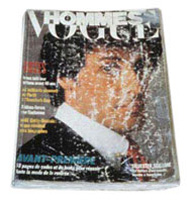
TP: Sylvester Stallone... locates it very definitely in the world of celebrity; it's not a faceless model, it's a celebrity. And I start to think about that in the context of, the reinvention of say, the elements of the magazine from the seventies, in the context of what's going on. Now if you watch SBS - and it's most prevalent on SBS - the ad breaks are fascinating. I love the ad breaks on SBS, not for what they tell me about any kind of product, but what they tell me about a particular sensitivity or sensibility.
Have you noticed that one of the most prevalent themes in advertising at the moment is the grey world? Where everything is grey, where if there's a flash of colour it's a break-light on a car, a little knick of red, or something like that. Everything is grey. There is one at the moment about 'Super(annuation)', or insurance, and there's the same guy sitting around a table in his grey world - there's no colour there! There are ones about motorcars, all sorts; they sell everything, they sell everything.
I started to think, what is this? I know who these ads are directed towards; they're directed towards people who are doing - the dot-com crowd - people who are making money out of... actually, actually doing nothing. There's a whole culture out there making money out of not producing a single thing. They don't produce, they sell insurance. What do they produce? Anxiety probably! Bankers, investment bankers - they're the worst! You know, people that buy and sell bags of wheat and bet on the price going up or down - what a weird life... but anyway.
It's their world, and in fact, that is the world. We've turned our world over to these people, we've turned our world over to them and that's the best they can do to decorate it. They claim to know all there is to know about everything, and are going to set it all right, for all of us. Instead they just paint it grey and filled it up with objects.
This brings me to Minimalism, because, in fact, and if anyone saw the Matthew Collings episode on Minimalism on telly last week, basically I'll just voice what he says. That there has been in art a tradition of making things disappear, and it starts with Kasimir Malevich. Malevich is the guy, the Suprematist, the Russian, who painted squares: black, white, you know, nothin', and of course no one, no one in the teens and twenties thought this was going to go anywhere - but then they didn't think Picasso was going to go anywhere either! What they hadn't banked on was that there's another process, it's the weirdest process at work, that parallels this rush to greed, this terminal rush to greed. It's that among the things that these people must acquire are pictures, and the more famous and tortured the artist the better! A famous tortured artist is going to acquire a good deal more cache, in the world of the dot-com millionaire, because he can talk about his struggle. But he has also acquired an object.
Now what's fascinating for me with all of this is, that Malevich starts out as an attempt to get rid of all material, anything material; all of the material world has to be excluded to focus on the spiritual. A more pretentious and later contender is Rothko. Rothko was on about the same thing... it's kind of a pointless exercise in the end because you are always going to be left with an object. And of course, when that object acquires enormous value, what then for the spiritual value? It reappears! So what you have is an odd process whereby the material world is drained out of an image in an attempt to replace it with the spiritual world, but then, the material world comes back, grasps it to its bosom, and it suddenly turns into the material world.
I suppose the most successful attempt to get rid of anything at all and succeed - because it became a subject of heated debate - was Carl Andre's bricks, Equivalent VIII, 1966. Because what he managed to do was he took all the artistry out of it, all of the artistry out, and then of course, the debate, instead of being centred around a tiny little group of people - you know, who all balance angels on pins interminably - the debate goes out of the museum, and out of the academy, and out into the street - 'I could have done that' (with gruff voice) - and everyone knows that if the damn things were put outside on the nature strip they'd just be a bunch of bricks; inside they're something else. But, in the end, they are just a bunch of bricks. Someone else made them - the artistry has been drained out of it though, there is no artistry left. And in a sense, that's what has happening in this work here, everything has being drained out of it...
(mobile phone rings)
Well, I'll end it there because basically that was the way I started to think about it. I started to think about it in terms of what the object was originally... and, of course, what it had become, and the fact that, in a sense, it is a metaphor for this process that goes on; the process of the celebrity, making and breaking celebrities, the way they disappear, they come and they go. In fact it's fascinating because if you took a magazine from the 1930's and read the list of celebrities that were there - because it's not a new phenomenon, it has always been around, in some form or another - no one will know who you are talking about. Celebrity is the most empty, empty of all pursuits; it's the weirdest.
ANONYMOUS: (answers mobile phone and gets up to leave) Sorry, its a grey-world car park calling
LB: Sell the car! Sell the car!
TP: There you go.
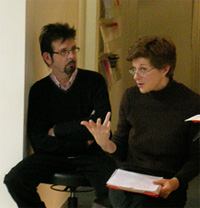
Tony Perry and Libby Brown are ad-hoc-consultants-at-large.
